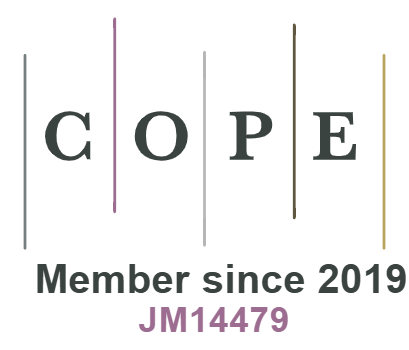Immersyjna rzeczywistość wirtualna jako środowisko badań społecznych. Wpływ obecności ucieleśnionego agenta na poziom wykonania zadania Stroopa na podstawie badań własnych
DOI:
https://doi.org/10.18778/0208-600X.86.01Słowa kluczowe:
rzeczywistość wirtualna, VR, immersyjna rzeczywistość wirtualna, facylitacja społeczna, hamowanie społeczne, zadanie Stroopa, interferencja Stroopa, ucieleśniony agent, badania społeczneAbstrakt
Badaniom poddany został wpływ obecności innych osób (fizycznego obserwatora i ucieleśnionych agentów) na wykonanie zadania Stroopa w immersyjnym środowisku wirtualnej rzeczywistości (VR). Opierając się na pracach przeprowadzonych przez Pascala Hugueta i współpracowników, którzy badali efekty facylitacji i hamowania społecznego w tradycyjnych warunkach laboratoryjnych za pomocą testu Stroopa, obecne badanie miało na celu przetestowanie tych efektów w warunkach VR. Uczestnicy zostali podzieleni na cztery grupy, z których każda przebadana była w innych warunkach – wykonując zadanie samodzielnie, ze świadomością bycia obserwowanym lub w obecności wcielonych agentów (formalnie ubranego dr Piotra lub nieformalnie Piotrka). W celu oceny wyników przeprowadzono jednoczynnikową analizę wariancji (ANOVA) dla niezależnych próbek. Wyniki wykazały znaczną redukcję interferencji Stroopa, gdy uczestnicy byli świadomi tego, że są obserwowani przez eksperymentatora. Jednak obecność ucieleśnionych agentów w środowisku VR, niezależnie od ich ubioru czy sposobu przedstawienia, nie wpłynęła znacząco na poziom wykonania zadania. Wyniki nie tylko potwierdziły występowanie efektu interferencji Stroopa w warunkach VR, porównaniu z tradycyjnymi warunkami laboratoryjnymi, ale także zasugerowały, że obecność społeczna eksperymentatora może poprawić wydajność wykonywania zadań w środowisku VR. Nie zaobserwowano jednak znaczącego wpływu obecności ucieleśnionego agenta. Obserwacje te mogą znacznie przyczynić się do rozwoju aplikacji VR. Jednak potrzebne są dalsze badania, w których uwzględnione zostaną takie czynniki, jak wielkość próby i realizm ucieleśnionych agentów.
Bibliografia
Baños R.M., Botella C., Perpiñá C. (1999), Virtual reality and psychopathology, “Cyberpsychology & Behavior”, vol. 2(4), pp. 283–292.
Google Scholar
DOI: https://doi.org/10.1089/cpb.1999.2.283
Baron R.S. (1986), Distraction-conflict theory: Progress and problems, [in:] L. Berkowitz (ed.), Advances in experimental social psychology, Academic Press, New York.
Google Scholar
DOI: https://doi.org/10.1016/S0065-2601(08)60211-7
Biocca F. (1997), The cyborg’s dilemma: progressive embodiment in virtual environments, “Journal of Computer-Mediated Communication”, 3:JCMC324, https://doi.org/10.1111/j.1083-6101.1997.tb00070.x (accessed: 17.08.2022).
Google Scholar
DOI: https://doi.org/10.1111/j.1083-6101.1997.tb00070.x
Bond C.F. Jr. (1982), Social facilitation: A self-presentational view, “Journal of Personality and Social Psychology”, vol. 42(6), pp. 1042–1050.
Google Scholar
DOI: https://doi.org/10.1037/0022-3514.42.6.1042
Bond C.F. Jr., Titus L.J. (1983), Social facilitation: A metanalysis of 241 studies, “Psychological Bulletin”, vol. 94(2), pp. 265–292.
Google Scholar
DOI: https://doi.org/10.1037/0033-2909.94.2.265
Botella C., Baños R.M., Garcia-Palacios A., Quero S. (2017), Virtual Reality and Other Realities, [in:] S.G. Hofmann, G. Asmundson (eds.), The science of cognitive behavioral therapy, Boston.
Google Scholar
DOI: https://doi.org/10.1016/B978-0-12-803457-6.00022-2
Brzezinska A. (2020), Od mediów do rzeczywistości. Jakie ryzyka i szanse niesie ze sobą popularyzacja VR?, Fundacja Centrum Cyfrowe, Warszawa.
Google Scholar
Cottrell N.B. (1972), Social facilitation, [in:] C.G. McClintock (ed.), Experimental social psychology, Holt, Rinehart & Winston, New York.
Google Scholar
Frankfort-Nachmias C., Nachmias D. (2001) Metody badawcze w naukach społecznych, Zysk i S-ka, Poznań.
Google Scholar
Freeman D., Pugh K., Vorontsova N. (2010), Testing the Continuum of Delusional Beliefs: An Experimental Study Using Virtual Reality, “Journal of Abnormal Psychology”, vol. 1, pp. 83–89.
Google Scholar
DOI: https://doi.org/10.1037/a0017514
Grzeszkiewicz-Radulska K., Wiktorowicz J., Grzelak M.M. (2020), Analiza statystyczna z IBM SPSS Statistics, Wydawnictwo Uniwersytetu Łódzkiego, Łódź.
Google Scholar
Huguet P., Galvaing M.P., Jean M., Monteil J.M., Dumas F. (1999), Social Presence Effects in the Stroop Task: Further Evidence for an Attentional View of Social Facilitation, “Journal of Personality and Social Psychology”, vol. 77(5), pp. 1011–1025.
Google Scholar
DOI: https://doi.org/10.1037/0022-3514.77.5.1011
Milgram P., Kishino F. (1994), A Taxonomy Of Mixed Reality Visual Displays, “IEICE Transactions on Information Systems”, vol. E77-D, no. 12, December.
Google Scholar
Okruszek E., Rutkowska A. (2013), Badanie kontroli wykonawczej za pomocą testu interferencji strupa u chorych na schizofrenię i osób z uszkodzeniami płatów czołowych, “Polskie Forum Psychologiczne”, vol. 18, no. 2.
Google Scholar
Slater M., Antley A., Davison A,. Swapp D., Guger C., Barker Ch., Pistrang N., Sanchez-Vives M.V. (2006), A Virtual Reprise of the Stanley Milgram Obedience Experiments, “PLOS ONE”, vol. 1(1): e39, https://doi.org/10.1371/journal.pone.0000039
Google Scholar
DOI: https://doi.org/10.1371/journal.pone.0000039
Smelser N. (1995), Social science: an imperfect art, “La Revue Tocqueville”, vol. 16, no. 1, pp. 3–24.
Google Scholar
DOI: https://doi.org/10.3138/ttr.16.1.3
Sosnowski T., (2004), Analiza kontrastów: między eksploracją a testowaniem hipotez, “Przegląd Psychologiczny”, vol. 47, no. 4.
Google Scholar
Śpiewak S, (1999), Wpływ bodźców supra i subliminalnych na efekt interferencji w zadaniu Stroopa, “Czasopisma Psychologiczne”, vol. 5, no. 2, pp. 129–139.
Google Scholar
Tomaszewska M., Markowska, A., Borkowska A. (2010), Test Stroopa – wartość diagnostyczna w psychiatrii, “Neuropsychiatria i Neuropsychologia”, vol. 5, no. 1, pp. 35–41.
Google Scholar
Triplett N. (1898), The Dynamogenic Factors in Pacemaking and Competition, “The American Journal of Psychology”, vol. 9(4), pp. 507–533.
Google Scholar
DOI: https://doi.org/10.2307/1412188
Vakil E., Manovivh R., Ramati E., Blachstein H. (1996), The Stroop Color-Word Task as a Measure of Selective Attension: Efficiency, “Developmental Neuropsychology”, vol. 12(3), pp. 313–315.
Google Scholar
DOI: https://doi.org/10.1080/87565649609540655
Wojciszke B. (2002), Człowiek wśród ludzi. Zarys psychologii społecznej, Wydawnictwo Naukowe Scholar, Warszawa.
Google Scholar
Zajonc R.B. (1965), Socjal Facilitation, “Science, New Series”, vol. 149, no. 3681, pp. 269–274.
Google Scholar
DOI: https://doi.org/10.1126/science.149.3681.269
Pobrania
Opublikowane
Wersje
- 30-09-2023 - (2)
- 30-09-2023 - (1)
Jak cytować
Numer
Dział
Licencja

Utwór dostępny jest na licencji Creative Commons Uznanie autorstwa – Użycie niekomercyjne – Bez utworów zależnych 4.0 Międzynarodowe.










